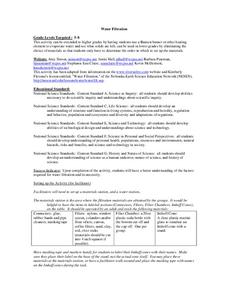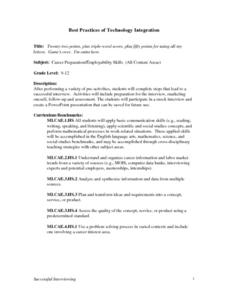Curated OER
Kure Waste Chase Game Lesson
Students work together to identify marine debris. They explain the effect of the debris on various ecosystems. They draw different types of ocean currents as well.
Curated OER
A Demonstration of Photo-and Geotaxes in Nauplii of Artemia Salina
Students explore phototaxis and geotaxis in brine shrimp. In this phototaxis and geotaxis lesson plan, students study the effects of light and gravity on brine shrimp using a test tube, a pen light and gravity. They answer questions...
Curated OER
A Century of Challenge and Change: The Filipino American Story
Students recognize the events that led to the Philippine Revolution. In this Philippine Revolution lesson, students relate the causes of the Philippine Revolution to situation in the world today. Students examine the Philippine Equation...
Curated OER
Using Words to Work Things Out
Third graders discuss ways to use words to solve a conflict. In this conflict resolution lesson, 3rd graders read the book Angela and Alice and discuss the conflict from the story. Students brainstorm ways to solve conflicts among...
Curated OER
Interfaith Dialogue
Young scholars explore interfaith dialogue. For this religion and ethics lesson, students examine the relationships among communities of faith as they design an interfaith association in their school community.
Curated OER
Pandas, Flamingos and Blogs
Students use the computer to discover animals. In this animal lesson, students look at online webcams to view animals and write in a daily blog discussing what the animals are doing. They use either Pixie or PowerPoint to create an...
Curated OER
What Makes a Cat a Cat?
Learners investigate the lives of pets by videotaping them. In this animal life lesson, students videotape a cat and other pets using school cameras in a computer lab. Learners review the footage from the cat and other animals and...
Curated OER
Water Filtration
Learners investigate our water system and how it is filtered. In this science activity, students perform a laboratory activity to investigate the process that goes into filtering water. They relate this activity to other subject areas...
Curated OER
Hermit Crabs in the Classroom
Young scholars interact with hermit crabs in the their classroom. In this hermit crab lesson, students handle and observe hermit crabs while learning about their habitats and how to treat animals. They watch how the animals move and...
Curated OER
Hawaii's Freshwater Animals - Species Report
Learners explore biology by creating a report for the class. In this oceanography lesson, students research and identify the survival characteristics of a list of freshwater animals by utilizing the Internet and library. Learners...
Curated OER
Creating a Textile Museum Piece from the Islamic Empire
Students create a drawing of an Islamic textile piece from the height of the Islamic Empire. Students describe the textile designs as symbolic representations of life in Islam during the 11th and 12th centuries.
Curated OER
The Sahara: Home of the Tuareg
Students research and analyze the Tuareg and other groups as well, including their own, and examine the impact culture has on environment.
Curated OER
Freshwater Habitats
Students take samples from local freshwater sources and examine them for macroinvertebrate life. They take samples from both shallow and deep freshwater environments, measure temperatures, and classify organisms found in their samples.
Curated OER
Creating a Heroic Character
Students answer a series of defining questions that lead them to develop a fully realized heroic character. They create a variety of multimedia representations of their hero, including video interviews, HyperStudio stacks, web pages, and...
Curated OER
Primary & Secondary Colors
Students identify primary and secondary colors and how they relate to each other, and experiment with mixing colors.
Curated OER
WHY IS LEONTES JEALOUS? FINDING A CAUSE IN THE WINTER'S TALE
Young scholars examine several possible ways of understanding Leontes' jealousy through close reading, a performance activity, and the use of a primary source document. They, in groups, perform a scene.
Curated OER
The Great Jellybean Hunt
Students explore natural selection and its influence on the populations to fine tune traits and characteristics. The acquisition of traits developed out of need is examined through a game played in class.
Curated OER
Storytellers: Pearl Jam
Young scholars examine the concept of freedom of speech as it applies to music. They watch and discuss the video, "VH1 Storytellers: Pearl Jam," participate in a class discussion about free speech, conduct research, and conduct a debate.
Curated OER
Predator Protector Game
Students take on the role of an Ocean Adventures expedition volunteer member and are charged with protecting three species of sharks from danger in order to defend the balance of nature in the ecosystem. They play an online game which...
Curated OER
The Urban Explosion
Students investigate the uncontrolled development of the world's major cities. They define key vocabulary terms, view and discuss video excerpts, and complete a project that involves drawing a "perfect city," developing a plan to...
Curated OER
Science: Bees: An Interdisciplinary Approach
Young scholars investigate the world of bees and describe their characteristics. by identifying the bees' parts, they demonstrate how these parts function. In the lab, students dissect bees and view the various parts under microscopes....
Curated OER
Successful Interviewing
After performing a variety of pre-activities, students will complete steps that lead to a successful interview. Activities will include preparation for the interview, marketing oneself, follow-up and assessment. The students will...
Curated OER
Trait Variations for Survival
Young learners examine how different traits could give one organism an advantage over another. In groups, they view two different organisms in different environments. To end the lesson plan, they complete a Venn Diagram on the two...
Curated OER
Animals, Soil, Trees
Fourth graders describe the various kinds of soils and how plants and animals are affected by them. They describe the baic needs of plants, scoring at least a 3 or 4 on a 4-point rubic. Students are able to predict and/or infer what...

























